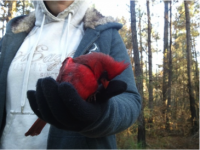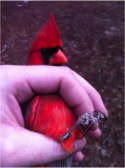Lake Thoreau Environmental Center
Research with Northern Cardinals
Page Content
Work by members of the Jawor lab at Lake Thoreau has used the Northern Cardinal (Cardinalis cardinalis) as the main species of interest, but the questions asked by students have been varied. The main research focus in the Jawor lab is Behavioral Endocrinology (the study of how hormones impact behavior) but we address questions concerning Behavioral Ecology and Physiology. Work is done in the field and lab by both graduate students and undergraduates.
Kaylee Gentry:
Kaylee’s thesis work at Lake Thoreau examines Northern Cardinal behavior with regards
to seasonal territoriality. Currently, there are over 20 mapped cardinal territories
with monitored pairs at Lake Thoreau. Kaylee’s work focuses on how cardinals see
neighbors and strangers in terms of level of threat they present and whether there
are seasonal changes in who is most threatening.  Currently work assessing behavior in the early breeding season has been completed
and Kaylee has found that with the onset of breeding, neighboring birds are considered
a much larger threat (and therefore are responded to very strongly in terms of aggressive
behavior) than out-population strangers are. Work will soon address the response
of individuals to strangers and neighbors during the non-breeding season, and will
include analyses for testosterone levels shown during aggressive responses to intruders.
Analysis of their behaviors in and out of breeding season allows us to delineate any
patterns in territory defensive strategies being utilized by the birds (e.g., are
birds more aggressive to strangers when there are more strangers around, like during
the non-breeding season, or are neighbors always the bigger threat for a territorial
cardinal).
Currently work assessing behavior in the early breeding season has been completed
and Kaylee has found that with the onset of breeding, neighboring birds are considered
a much larger threat (and therefore are responded to very strongly in terms of aggressive
behavior) than out-population strangers are. Work will soon address the response
of individuals to strangers and neighbors during the non-breeding season, and will
include analyses for testosterone levels shown during aggressive responses to intruders.
Analysis of their behaviors in and out of breeding season allows us to delineate any
patterns in territory defensive strategies being utilized by the birds (e.g., are
birds more aggressive to strangers when there are more strangers around, like during
the non-breeding season, or are neighbors always the bigger threat for a territorial
cardinal).
B. Matthew Duckworth:
Matt’s thesis work at Lake Thoreau examines patterns in a different hormone, the ‘stress’
hormone corticosterone. Corticosterone’s main role is to provide extra energy to
an animal via elevation of glucose and it is released both during stressful events
(e.g., being chased by a predator) and also during normal, non-stressful, daily activities
like waking up (e.g., one needs a burst of energy to get going after being asleep). In addition to daily variation in corticosterone there
are annual patterns in birds as well; corticosterone tends to be much higher during
the breeding season and lower during the winter. Matt has found that in cardinals,
much like with the hormone testosterone, patterns observed in corticosterone levels
do not match what is generally seen in other species. Cardinals tend to have higher
corticosterone levels in the non-breeding season than during the breeding season.
Stress responses (the elevation of corticosterone following a standardized stressor,
in this case being held by a researcher) are blunted in both sexes during the breeding
season and become very elaborate during the non-breeding season. As cardinals are
descended from a tropical ancestor, cooler winters, even in the southeastern United
States, may select for elevated energy needs in the non-breeding season. The relatively
long breeding season cardinals express may select for lower corticosterone levels
and blunted stress responses to guard against any reduction in breeding.
going after being asleep). In addition to daily variation in corticosterone there
are annual patterns in birds as well; corticosterone tends to be much higher during
the breeding season and lower during the winter. Matt has found that in cardinals,
much like with the hormone testosterone, patterns observed in corticosterone levels
do not match what is generally seen in other species. Cardinals tend to have higher
corticosterone levels in the non-breeding season than during the breeding season.
Stress responses (the elevation of corticosterone following a standardized stressor,
in this case being held by a researcher) are blunted in both sexes during the breeding
season and become very elaborate during the non-breeding season. As cardinals are
descended from a tropical ancestor, cooler winters, even in the southeastern United
States, may select for elevated energy needs in the non-breeding season. The relatively
long breeding season cardinals express may select for lower corticosterone levels
and blunted stress responses to guard against any reduction in breeding.